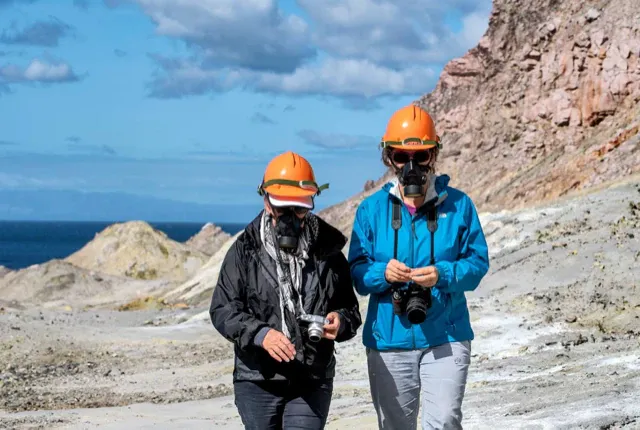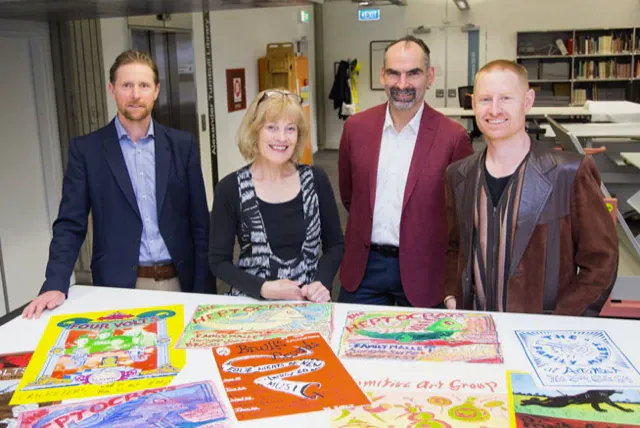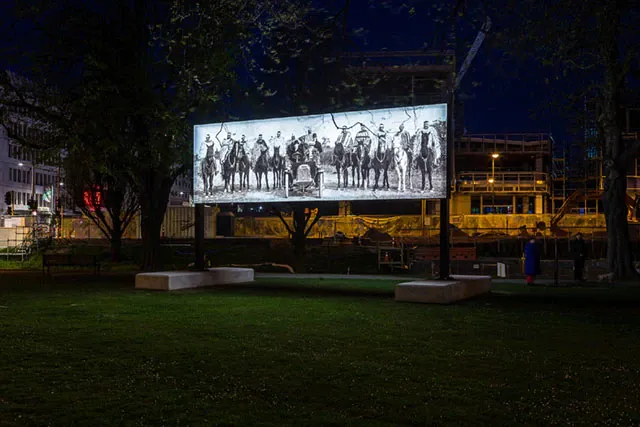Mark Amery's Lowdown #5
Written by
The Arts in Budget 2018
“Arts and culture are not a ‘nice to have’…For too long they have been treated differently when it comes to sustainable growth, career paths and economic benefits.” That’s the Prime Minister of New Zealand, Jacinda Ardern in her role as Minister for Arts, Culture and Heritage making her Budget 2018 announcement.
Adern says Budget 2018 lays “the foundations for a significant programme of work that highlights the essential role the cultural sector plays in the wellbeing of our society.” Nice words, but there’s a lot of wait-and-see in terms of actual significant change to back that up. The bulk of new funding, $23.3 million, went to Ministry of Culture and Heritage’s baseline funding over the next four years, followed by an $6.3 million increase to Heritage New Zealand and $2.6 million to the New Zealand Music Commission.
What will the Ministry do with its share? “..look at a 10-year strategy to grow our screen industry, the best ways to re-invigorate the Pathways to Arts and Cultural Employment (PACE) initiative, and how the creative sector can help foster talent and inspire young people through the school curriculum.”
Little investment then yet of direct benefit to artists and their infrastructure, changes to Creative New Zealand support, or to the museums sector. Artist in employment schemes and changes to the place arts in education are very welcomed: but the ideas don’t seem to have moved into any detail from last year’s Labour Party manifesto.
It’s a step towards some key aspirations from the arts sector (which we collected in November in writing here) - but that community is being quietly patient.
The Prime Minister taking up the arts, culture and heritage portfolio, shared with Grant Robertson and Carmel Sepuloni doesn’t seem to have affected the arts near invisibility when it comes to media analysis. With the exception of Ben Howe of Flying Nun on the change for musicians and a few jokes from Oscar Kightley, even Spinoff didn’t manage to get comments from anyone in the arts in their gathering of Budget reactions.
We need more advocacy from within the sector. By contrast after the May 8 Federal budget announcement in Australia that country’s National Association for the Visual Arts called the Federal budget out for having “shirked its key responsibility to offer a vision for the Australian culture.” Live Performance Australia commented on there being “nothing there in terms of new policy initiatives or investment to support the live performance industry’s growth.”
Re-establishing PACE is something Wellington mayor Justin Lester (who holds his city’s arts and culture portfolio) said he would hold the government to account for earlier in the month in this Urban Dreams podcast. Speaking to Sophie Jerram, Lester also talked about the $127 million that has been prioritised for the arts in Wellington over the last 10 years, plans by council for affordable housing - in which he sees artists a vital part of that mix - and treating artists the same as start-up businesses.
Gongs
Pip Adam won the big prize at the Ockham New Zealand Book Awards, the Acorn Foundation Fiction Prize for her smart 2017 novel The New Animals. Those who’ve read the book will appreciate the significance of its break with convention, something alluded to with no spoilers in interesting pieces on their decision-making process by judges Philip Matthews and Anna Smail in Stuff and Noted, respectively. “The inescapable fact is that if VUP (Victoria University Press) fell into a Wellington sinkhole, the best New Zealand fiction would disappear overnight,” quipped Matthews. Pip Adam spoke on RNZ’s Nine to Noon here.
“What will not go away is the sense that this is yet another artwork in which black trauma functions as ready-to-wear cultural clothing,” wrote Nick Scammell recently of Luke Willis Thompson’s Autoportrait in ASX. Ouch. Yes, it’s the work that continues to polarise people, even if they haven’t seen it. I for one find the criticism of the work just as shallow and offensive.
Shortlisted for the Turner Prize (discussed last Lowdown), Autoportrait has now won the prestigious 2018 Deutsche Börse Photography Prize in the UK. This is introduced well by photography critic Sean O’Hagan in the Guardian here, echoing the work’s strong reception in the mainstream but also noting Scammell’s criticism: the concern some have with Diamond Reynold’s silence in the film and questioning the collaboration with the artist.
Debate around Autoportrait is sure to escalate when the work is on at London’s Tate Britain from September. Meantime, the shortlisted works for the Deutsche Börse are at London’s The Photographers Gallery until 3 June (video of the installation here). It was at the Adam Art Gallery in Wellington earlier this year – so surely we can arrange a higher profile showing in Auckland – previously shown at his dealers Hopkinson Mossman - so more than just the art crowd few can enter the discussion?
May has also seen the Arts Foundation announce its new Icon Awards: Billy Apple, Fred Graham, Bill Manhire, Maualaivao Albert Wendt and Dame Gillian Karawe Whitehead. The awards are for “a living circle” of twenty artists. A medallion designed by John Edgar has been handed on from the whanau of the late Sir Ian Athfield, Jack Body, Marti Friedlander, Peter Godfrey and Dr Cliff Whiting. Amongst the media I really enjoyed interviews with ‘World Famous in Waiuku’ Fred Graham in The Post and with Kim Hill here.

Christchurch artists Edwards + Johann on White Island as part of their pilot Whakatane Museum Volcanic residency. Image: Troy Baker.
In residence
It gladdens the heart to see artist residencies proliferate in all sorts of new permutations. They’re vital in giving artists much needed security and connection into communities.
Great to see more in the regions. Whakatane Museum is connecting the mainland to the active volcano of White Island through the country’s first Volcanic Arts Residency. “We think that profound and unexpected artistic inspiration can come from deep connections to geothermal activity, otherworldly landscapes, and subterranean mysteries. That's our thesis, as the earth boils below,” says the museum’s Eric Holowacz. The residency is not due to launch until later this year but they’ve started socialising the idea by sharing a visit by Christchurch-based artists Edwards and Johann to the island, documented in beautiful photographs by Troy Baker in this publication. The duo are exhibiting their work at the museum.
Selwyn District Council meanwhile has announced its first residency. Ngāi Tahu artist, Emma Riha Kitson is the first of four in the rural central Canterbury region’s libraries over the next year. Riha Kitson, Canterbury-born and Wellington-based, will be working from Darfield Library during Matariki. Using printmaking methods whānau can use at home, she’s exploring traditional Māori stories through the making of bunting.
On the subject of out-of-the-way residencies I also wanted to share for inspiration this online diary from Wellington public art duo Kemi and Niko from their recent 10 day residency at Time Place Space: Nomad, a research residency, out camping in the remarkable landscape of regional Victoria.
Musician and sound artist Daniel Beban (best known for Orchestra of Spheres) is the recipient of not one but two residencies. Beban has been awarded the prestigious Lilburn Research Fellowship for 2019 by The Alexander Turnbull Library and Lilburn Trust. Beban will research the Braille Collective, who made up groups such as the Six Volts and the Primitive Art Group in mid-1980s Wellington. He’ll produce a book about the collective and New Zealand improvised music from the late ‘70s on.
Beban this month is a 2018 Audio Foundation Performance Residency artist, spending a week in residence at the Audio Foundation’s basement grotto on Myers Park in downtown Auckland from May 22, performing each night with collaborators both old and new. Previously in residence was Auckland musician Ron Gallipoli. Beban is also presenting an exhibition at the Foundation until June 2 that collects together work he has made on visits to China over 15 years.

Alexander Turnbull Library curators (left to right), Michael Brown, Barbara Lyon and Keith McEwing with Lilburn Research Fellow Daniel Beban. Photo by Mark Beatty, National Library of New Zealand Te Puna Mātauranga o Aotearoa.
Movements
Nathan Pohio's public artwork 'Raise the anchor, unfurl the sails, set course to the centre of an ever setting sun!' which appeared at Documenta 2017 in Athens and in the Walters Prize in Auckland, is to return to Christchurch and be reinstalled before public art platform Scape’s 20th anniversary celebrations in October. As reported here on Star.Kiwi this for Pohio is about his ancestors returning home.
What has been billed as the Wellington region’s largest public artwork, Lightwing has been installed on a roundabout in the industrial suburb of Seaview in Lower Hutt. Video of its creation is at NZ Herald. The giant steel work is by Andrew Thomas, a Wellington production designer previously known for his work in theatre and film.
Just launched is the programme for the outstanding Kia Mau theatre and dance festival in Wellington, 1-16 June. Now in its fourth year the festival has become a cornerstone of the presentation and development of Maori, Pasifika and indigenous work, working from an indigenous kaupapa. You can view the exciting programme here. It ranges from @Wāhine Works production of Waiora: Te-ū-kai-po (The Homeland) which “began as a class assessment for students at Whāngarei Girls’ High School and grew into a three season smash hit in Whāngarei and, when Don Brash came, a national news story” to Cherish Violet Blood in Deer Woman a work from Turtle Island Canada.
Auckland Art Gallery Toi o Tāmaki have launched a chatbot through Facebook Messenger. I gave it a go by typing in ‘Show me Michael Parekowhai’ into Messenger on Facebook here. A new way to explore the gallery’s collection, “users are able to send prompts – such as ‘show me…,’ ‘send me…’ or ‘give me…’ – followed by a keyword, colour or, even, an emotion, and the chatbot will respond with a selection of related artworks.” It’s part of an initiative led by the San Francisco Museum of Modern Art who launched their text message-based chatbot in July 2017. SFMOMA shared basic code behind the chatbot, so that other institutions around the world could adapt it for their own collections.

Nathan Pohio, Raise the anchor, unfurl the sails, set course to the centre of an ever setting sun!, 2015. Commissioned by SCAPE Public Art. Image courtesy of the artist and Jonathan Smart Gallery, Christchurch. Photo by Hannah Watkinson.
Reading
Each Lowdown we signpost to significant writing and channels on the New Zealand arts online. Here’s a few we previously haven’t mentioned.
A good gateway to strong content is The New Zealand Festival’s occasional online Article Magazine, founded by Guy Somerset. A new issue is out. Recommended: Dowse Art Museum Director Courtney Johnston writing on three current works at the museum.
Photoforum have, with funding from Creative New Zealand and Baker Douglas, started a series of reviews and essays online. Recent content includes Mary Jane Duffy on the current Marie Shannon survey exhibition at Adam Art Gallery.
Shannon joins Megan Dunn in conversation in a new Circuit podcast series of Artists in Conversation. For this podcast Thomasin Sleigh replaces me in the facilitation chair.
And if you weren’t one of those filling 74,000 seats at Auckland Writers Week, not only is there Renee Liang’s blog at The Big Idea, The Reader the Booksellers blog features a range of reviewers on different sessions. Graham Beattie also reported on the festival here, at Beattie’s Book Blog.
Australian art publications have for a long time given some occasional presence to reviews of New Zealand exhibitions. Recent writing includes a lengthy look at the new Michael Parekowhai work Detour and Pacific Sisters exhibition at Te Papa by Bruce E Philips in Artlink.
Un Magazine has been published from Melbourne since 2004. The new issue is themed on decolonisation. Natasha Matila-Smith considers the difficulty of expecting indigenous artists to be declamatory about identity, writing on New Zealand artists Talia Smith and Faith Wilson. Matila-Smith has also published this month an article online about the work of painter Yukari Kaihori on Hainamana a website devoted to writing on Asian New Zealand art and culture.
At Pantograph Punch Kate Prior has published a substantial analysis on the demise of the Fortune Theatre, which closed 1 May. “The Fortune couldn’t adapt in time,” Prior writes. “It’s closure wasn’t entirely due to the constant struggle to get bums on seats, but the creakingly slow wheels of governance.”
Welcomingly Prior spends time considering new models for Dunedin professional theatre’s future, rather than laying it at the door of the Fortune’s board. “It's worth considering, that perhaps Dunedin's professional mainstage, which also serves the regions, doesn’t need a building.”
The second part of Prior’s article does however emphasise what a huge importance a building, a home for theatre becomes for people. It collects the thoughts and recollections from theatre practitioners of all ages. It’s a powerful testament to the special place of a theatre.
Also on the Fortune Theatre Hilary Halba has written a powerful eulogy on international review site Theatre Times. Also check out David O’Donnell’s review of David Mamea’s Still Life With Chickens, currently at Circa Theatre. O’Donnell connects the play to an Otago University study that found that elderly Pacific Islanders are the most likely ethnicity to suffer from loneliness. “Loneliness and discomfort, and their relation to larger social and economic structures” happened to be the subject of exhibition If you miss me, let me know by Matila-Smith and Talia Smith at Meanwhile gallery in Wellington earlier in the month..
Want more of the Lowdown? Check out Mark Amery's past Arts Media Lowdowns here and subscribe to our weekly bulletin so it comes straight to your inbox.
News and content ideas are welcomed for future editions of Arts Media Lowdown. Please send to mark.amery@thebigidea.co.nz